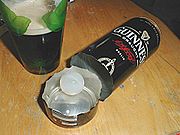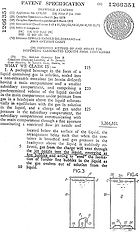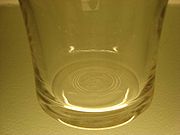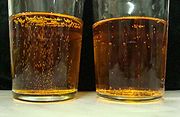
Widget (beer)
Encyclopedia

Beer head
Beer head is the frothy foam on top of liquid beer after it is poured in a glass. It is produced by bubbles of carbon dioxide rising to the surface....
. The original widget was patented in Ireland by Guinness
Guinness
Guinness is a popular Irish dry stout that originated in the brewery of Arthur Guinness at St. James's Gate, Dublin. Guinness is directly descended from the porter style that originated in London in the early 18th century and is one of the most successful beer brands worldwide, brewed in almost...
. The "floating widget" is found in cans of beer
Beer
Beer is the world's most widely consumed andprobably oldest alcoholic beverage; it is the third most popular drink overall, after water and tea. It is produced by the brewing and fermentation of sugars, mainly derived from malted cereal grains, most commonly malted barley and malted wheat...
as a hollow plastic sphere, 3 cm in diameter (similar in appearance to a small table tennis
Table tennis
Table tennis, also known as ping-pong, is a sport in which two or four players hit a lightweight, hollow ball back and forth using table tennis rackets. The game takes place on a hard table divided by a net...
ball) with a small hole in one side. The "rocket widget" is found in bottles, 7 cm in length with the small hole at the bottom.
Background
Draught Guinness, as it is known today, was first produced in 1964. With Guinness keen to produce draught beerDraught beer
Draught beer is beer served from a cask or a pressurised keg.-History of draught:Until Joseph Bramah patented the beer engine in 1785, beer was served directly from the barrel and carried to the customer. The Old English word for carry was dragen which developed into a series of related words,...
packaged for consumers to drink at home, Bottled Draught Guinness was formulated in 1978 and launched into the Irish market in 1979. It was never actively marketed internationally as it required an "initiator" device, which looked rather like a syringe, to make it work.
Method
Some canned beers are pressurized by adding liquid nitrogenLiquid nitrogen
Liquid nitrogen is nitrogen in a liquid state at a very low temperature. It is produced industrially by fractional distillation of liquid air. Liquid nitrogen is a colourless clear liquid with density of 0.807 g/mL at its boiling point and a dielectric constant of 1.4...
, which vaporises and expands in volume after the can is sealed, forcing gas and beer into the widget's hollow interior through a tiny hole—the less beer the better for subsequent head quality. In addition, some nitrogen dissolves in the beer which also contains dissolved carbon dioxide
Carbon dioxide
Carbon dioxide is a naturally occurring chemical compound composed of two oxygen atoms covalently bonded to a single carbon atom...
. It is important that oxygen
Oxygen
Oxygen is the element with atomic number 8 and represented by the symbol O. Its name derives from the Greek roots ὀξύς and -γενής , because at the time of naming, it was mistakenly thought that all acids required oxygen in their composition...
be eliminated from any process developed as this can cause flavour deterioration when present.
The presence of dissolved nitrogen allows smaller bubble
Liquid bubble
A bubble is a globule of one substance in another, usually gas in a liquid.Due to the Marangoni effect, bubbles may remain intact when they reach the surface of the immersive substance.-Common examples:...
s to be formed thereby increasing the creaminess of the head. This is because the smaller bubbles need a higher internal pressure to balance the greater surface tension
Surface tension
Surface tension is a property of the surface of a liquid that allows it to resist an external force. It is revealed, for example, in floating of some objects on the surface of water, even though they are denser than water, and in the ability of some insects to run on the water surface...
, which is inversely proportional to the radius
Radius
In classical geometry, a radius of a circle or sphere is any line segment from its center to its perimeter. By extension, the radius of a circle or sphere is the length of any such segment, which is half the diameter. If the object does not have an obvious center, the term may refer to its...
of the bubbles. Achieving this higher pressure would not be possible with just dissolved carbon dioxide, as the greater solubility of this gas compared to nitrogen would create an unacceptably large head.
When the can is opened, the pressure in the can quickly drops, causing the pressurised gas and beer inside the widget to jet out from the hole. This agitation on the surrounding beer causes a chain reaction of bubble formation throughout the beer. The result, when the can is then poured out, is a surging mixture in the glass of very small gas bubbles and liquid.
This is the case with certain types of draught beer
Draught beer
Draught beer is beer served from a cask or a pressurised keg.-History of draught:Until Joseph Bramah patented the beer engine in 1785, beer was served directly from the barrel and carried to the customer. The Old English word for carry was dragen which developed into a series of related words,...
such as draught stout
Stout
Stout is a dark beer made using roasted malt or barley, hops, water and yeast. Stouts were traditionally the generic term for the strongest or stoutest porters, typically 7% or 8%, produced by a brewery....
s. In the case of these draught beers, which before dispensing also contain a mixture of dissolved nitrogen and carbon dioxide, the agitation is caused by forcing the beer under pressure through small holes in a restrictor in the tap. The surging mixture gradually settles to produce a very creamy head.
Development

Development work on a can system under Project ACORN (Advanced Cans Of Rich Nectar) focused on an arrangement whereby a false lid underneath the main lid formed the gas chamber (see diagram below right).
Technical difficulties led to this approach being put on hold, and Guinness instead concentrated on bottles using external initiators. Subsequently, Guinness allowed this patent to lapse and it was not until Ernest Saunders centralised the company's research and development
Research and development
The phrase research and development , according to the Organization for Economic Co-operation and Development, refers to "creative work undertaken on a systematic basis in order to increase the stock of knowledge, including knowledge of man, culture and society, and the use of this stock of...
in 1984 that work restarted on this invention, under the direction of Alan Forage.
The design of an internal compartment that could be readily inserted during the canning process was devised by Alan Forage and William Byrne, and work started on the widget during the period 1984–85. The plan was to introduce a plastic capsule into the can, pressurise it during the filling process and then allow it to release this pressure in a controlled manner when the can was opened. This would be sufficient to initiate the product and give it the characteristic creamy head. However, Tony Carey observed that this resulted in beer being forced into the widget during pasteurisation, which reduced the quality of the head. He suggested overcoming this by rapidly inverting the can after the lid was seamed on. This extra innovation proved successful.
The first samples sent to Dublin were labelled "Project Dynamite", which caused some delay before customs and excise would release the samples. Because of this the name was changed to Oaktree in recognition of the earlier ACORN project. Another name that changed was "inserts"; the operators called them "widgets" almost immediately after they arrived on site, a name that has now stuck with the industry.
The development of ideas continued and more than one hundred alternatives were considered. The blow-moulded widget was to be pierced with a laser and a blower was then necessary to blow away the plume created by the laser burning through the polypropylene. This was abandoned and instead it was decided to gas-exchange air for nitrogen on the filler, and produce the inserts with a hole in place using straightforward and cheaper injection-moulding techniques.
Commissioning began January 1988, with a national launch date of March 1989. This first-generation widget was a plastic disc held in place by friction in the bottom of the can. This method worked fine if the beer was served cold; when served warm the can would overflow when opened. The floating widget, which Guinness calls the "Smoothifier", was launched in 1997 and does not have this problem.
The diagrams on the right show the development sequences for canned and bottled draught Guinness from 1969 to 1988
As the widget is a plastic material it can cause problems when the can is recycled. Users of cans containing widgets are often requested to remove them before recycling the can.
Beer glass widget


Laser
A laser is a device that emits light through a process of optical amplification based on the stimulated emission of photons. The term "laser" originated as an acronym for Light Amplification by Stimulated Emission of Radiation...
-etched
Etching (glass)
__FORCETOC__Etching refers to the technique of creating art on the surface of glass by applying acidic, caustic, or abrasive substances. Traditionally this was done after the glass was blown or cast.- Techniques :...
pattern at the bottom of a beer glass which aids the release of carbon dioxide bubbles. The pattern of the etching can be anything from a simple circular or chequered design to a logo or text.
The widget in the base of a beer glass works by creating a nucleation point, allowing the CO2
Carbon dioxide
Carbon dioxide is a naturally occurring chemical compound composed of two oxygen atoms covalently bonded to a single carbon atom...
to be released from the liquid which comes into contact with it, thus assisting in maintaining head on the beer.

